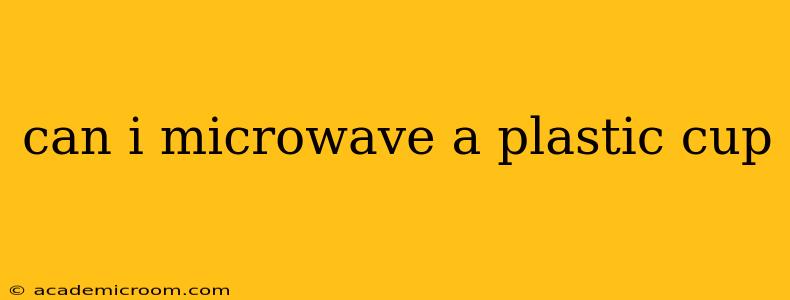Can I Microwave a Plastic Cup? A Comprehensive Guide to Microwave-Safe Plastics
The short answer is: it depends. Not all plastic cups are microwave-safe. Microwaving the wrong type of plastic can lead to the leaching of harmful chemicals into your food and drink, and in some cases, even melting or warping of the cup itself. Understanding the different types of plastics and their microwave suitability is crucial for safe food preparation.
What Makes a Plastic Cup Microwave-Safe?
The key is looking for the recycling symbol on the bottom of the cup, usually a number within a triangle. This number indicates the type of plastic used. Only certain types are designed to withstand the high temperatures of a microwave. Look for a #5 (PP) or #7 (other), but even then, always check the manufacturer's instructions printed on the cup itself. The label might explicitly state whether it's microwave-safe or not.
What Happens if I Microwave a Non-Microwave-Safe Plastic Cup?
Microwaving non-microwave-safe plastics can have several undesirable consequences:
- Chemical Leaching: The heat can cause chemicals from the plastic to leach into your food or drink. Some of these chemicals are known to be potentially harmful to health with long-term exposure.
- Melting or Warping: The plastic might melt, warp, or become deformed, rendering the cup unusable and potentially creating a mess in your microwave.
- Burning or Catching Fire: In extreme cases, the plastic could catch fire, posing a significant safety hazard.
Which Plastic Cups Should I Avoid Microwaving?
Avoid microwaving cups made from the following plastics:
- #1 (PET or PETE): Polyethylene terephthalate is not designed for repeated heating and can leach chemicals under high temperatures.
- #2 (HDPE): High-density polyethylene is generally considered safe for cold liquids, but repeated heating may degrade the plastic.
- #3 (PVC): Polyvinyl chloride can release harmful chemicals when heated.
- #4 (LDPE): Low-density polyethylene, while generally safe for short periods, is not recommended for microwaving.
- #6 (PS): Polystyrene (Styrofoam) should never be microwaved. It melts easily and releases harmful chemicals.
Are All #5 and #7 Plastics Microwave-Safe?
While #5 (polypropylene) and #7 (other) plastics are often microwave-safe, it's crucial to always check the manufacturer's instructions. Some #5 and #7 plastics may contain additives or coatings that aren't microwave-safe. Don't assume anything—always look for explicit microwave-safe labeling.
What if I Don't See a Recycling Symbol?
If the plastic cup doesn't have a recycling symbol, it's best to err on the side of caution and avoid microwaving it. The safest option is to use a microwave-safe container specifically designed for food preparation.
What are the best alternatives to plastic cups for microwaving?
Consider using microwave-safe glass or ceramic containers. These materials are generally inert and won't leach chemicals into your food. Some manufacturers produce specific microwave-safe plastic containers; these are often clearly labeled as such. Always check the manufacturer's instructions before using any container in the microwave.
In conclusion, while some plastic cups might be microwave-safe, it's essential to always check the label and identify the type of plastic before heating. When in doubt, use a microwave-safe alternative to ensure your safety and avoid potential health risks.
